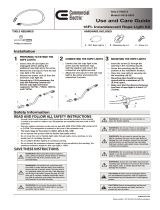
2
Table of Contents
Overview
Using This Manual ................................................ 4
Precautions for Preventing Access to the Camera
by an Unintended Third Party ............................ 5
Features .................................................................. 6
Location and Function of Parts ........................... 7
Camera ............................................................ 7
Remote commander (supplied) ..................... 10
System Configuration ......................................... 13
Operating the camera using the supplied remote
commander ................................................... 13
Operating the camera using the remote
controller (not supplied) ............................... 13
Connecting multiple cameras to the remote
controller (not supplied) ............................... 14
Installation and Connection
Installing the Camera ......................................... 15
Installing the camera on a desk ..................... 15
Installing the camera at a high spot .............. 16
Connecting the Camera ...................................... 23
Connecting an AC power supply .................. 23
Connecting the camera to a PoE+ (Power over
Ethernet Plus) power supply device .............. 23
Connecting a single camera to a switcher,
recorder and monitor .................................... 24
Connecting a single camera to a single remote
controller (not supplied) ............................... 25
Connecting a single camera to a single remote
controller (not supplied) ............................... 25
Connecting multiple cameras to a single remote
controller (not supplied) ............................... 26
Connecting a commercially available video
switcher ......................................................... 26
Externally synchronizing a single camera .... 28
Adjusting and Configuring through
On-Screen Menus
About On-Screen Menus .................................... 29
Confirming selection of menu items and settings
/ Executing operations .................................. 29
Main menu .................................................... 29
Setting menu ................................................. 29
How to Use Menus ...............................................30
Using the supplied remote commander .........30
EXPOSURE Menu ..............................................31
COLOR Menu .....................................................33
DETAIL Menu .....................................................34
KNEE Menu .........................................................35
GAMMA/VISIBILITY ENHANCER Menu ....36
GAMMA .......................................................36
VISIBILITY ENHANCER ...........................36
FOCUS Menu ......................................................37
PICTURE/OPTICAL FILTER Menu ...............37
PAN TILT/ZOOM Menu ....................................38
VIDEO OUT Menu .............................................40
SYSTEM Menu ....................................................40
NETWORK Menu ...............................................41
PICTURE PROFILE Menu ...............................42
PTZ TRACE Menu .............................................43
Recording pan/tilt and zoom operations .......43
Playing pan/tilt and zoom operations ............43
Deleting recorded pan/tilt and zoom
operations ......................................................44
Operations Using the Supplied
Remote Commander
Before Starting Operations .................................45
Turning on the Power ..........................................45
Pan/Tilt and Zoom Operations ...........................45
Panning and tilting ........................................45
Zooming ........................................................46
Operating multiple cameras with the remote
commander ....................................................46
Adjusting the Camera .........................................47
Focusing on a subject ....................................47
Shooting with back lighting ..........................47
Storing the Camera Settings in Memory
– Preset Feature ...................................................48
Storing the camera status ..............................48
Recalling stored status ..................................48
Clearing the preset memory ..........................48
Storing Camera Pan/Tilt and Zoom Operations
– PTZ TRACE function ......................................49
Recording pan/tilt and zoom operations .......49
Playing pan/tilt and zoom operations ............49
Deleting recorded pan/tilt and zoom
operations ......................................................49
Accessing from a Web Browser
Before starting the operation ..............................50
Setting-up the PC ..........................................50






















